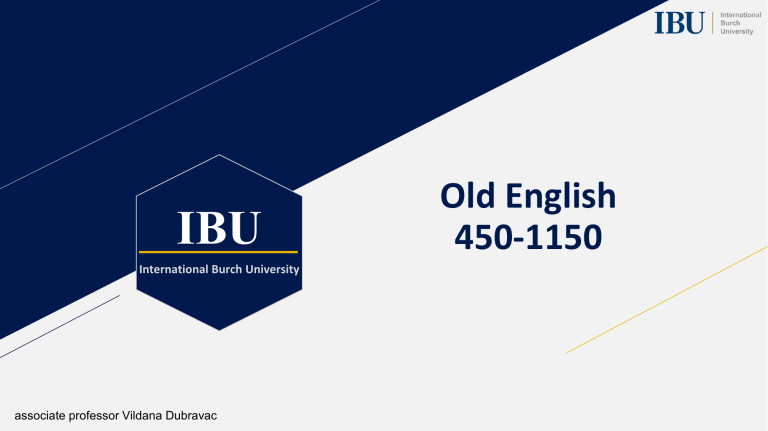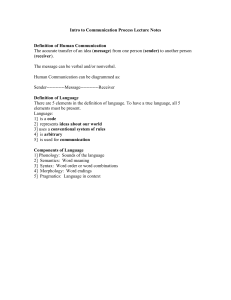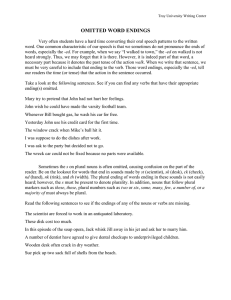
IBU International Burch University associate professor Vildana Dubravac Old English 450-1150 Started around 449 - Germanic tribes Latin influences - missionaries from Rome French influences - Norman invasion in 1066 Existing evidence -collection of texts from a variety of regions Differs from Modern English in: Spelling Phonetics Morphology Syntax Sources Manuscripts written on vellum Books owned by a monastery, a church, or a wealthy person Facsimile editions Available in transliterated form Most remaining texts religious, legal, medical, literary Texts divided into Northumbrian, Mercian, West-Saxon, Kentish Spelling Use of modified Roman alphabet Introduced by Irish missionaries Letter shapes not identical to those of Modern English æ (called ash) þ (called thorn) ð (called eth) - the last two used interchangeably W - one or two U; also runic ÷ (and called wynn or wen) Spelling Capital letters and punctuation marks mostly absent Abbreviations frequently used Symbols for and: Spelling Spelling OE preserved in carvings on wood and stone from the 7th century Runic alphabet - futhorc Spelling Spelling The inscription reads: folcæarærdonbecbiddaþfoteæþelmun Word-by-word gloss and free translation: People reared beacon pray for Aethelmund ‘People put up a sign and pray for Aethelmund’ Nu scylun hergan hefaenricaes uard Nu scylun hergan hefaenricaes uard Now should praise-INF heaven-kingdom-GEN quardian Now we should praise the quardian of the heavenly kingdom. Sounds Four changes: Voicing Palatalization Breaking Fronting Alliteration Sounds - voicing V of heaven is written as F in hefaen Sounds - voicing Remnants of the phenomenon seen in wife, half, knife, leaf - [f] in word-final position, [v] in the plural - wives, halves, knives, leaves (between two vowels) Final voiced fricatives the result of later deletion of the final vowel house, bathe Words with initial [z] or [v] are mostly loans Sounds - voicing Influx of new words - boost after 1066 From Greek in 16th and 17th centuries Due to external contact, but since several sounds are added to the phoneme inventory, it caused internal change Sounds - palatalization Velars [k], [sk] and [g] fronted, in particular before front vowels Velar sounds are not fronted before back vowels Germanic skirt becomes OE shirt, skatter becomes shatter, kirk becomes church, egg becomes eye Some of the words co-exist, in other cases one of the two forms wins Sounds - breaking When front vowels æ, e and i become diphthongs before certain consonants Ald and half become eald and healf, werc becomes weorc Rule applies when the vowel is followed by an L or R or H Assimilatory change Sounds - fronting Also called i-umlaut Happens when a back vowel such as o or u precedes an i The i-ending subsequently disappears and the cause of the fronting becomes hidden Non-fronted and fronted forms now form singular and plural pairs (goose - geese), as well as transitive and intransitive pairs (fall - fell) mouse –mice; louse – lice; foot – feet; tooth – teeth; man - men; sit - set goose geese Gmc. /go:s/ /go:si/ i-Umlaut (fronting!): /o:/ > /ø:/ / _ /i/ /go:s/ /gø:si/ Loss of /i/ /go:s/ /gø:s/ Unrounding of /ø:/ > /e:/ /go:s/ /ge:s/ GVS: /o:/ > /u:/; /e:/ > /i:/ /gu:s/ /gi:s/ mouse mice Gmc. /mu:s/ /mu:si/ i-Umlaut (fronting!): /u:/ > /y:/ / _/i/ /mu:s/ /my:si/ Loss of /i/ /mu:s/ /my:s/ Unrounding of /y:/ > /i:/ /mu:s/ /mi:s/ GVS: /u:/ > /au/; /i:/ > /maus/ [+front] [+high] [+low] [+back] i y u e ø o æ a Sounds GVS has not taken place yet Vowels are still low Name, meet, mine, book, now [namә], [met], [min], [bok], and [nu] G or Usually pronounced as [j] at the end of a word and before a front vowel (daeg) Voiced fricative [y] before back vowels Sounds H in words such as niht, leoht, cniht (night, light, knight) represented phonetically as [X] - voiceless velar fricative Final sound of loch in Modern English Sounds - alliteration Involves word-initial consonants that are similar Mainly relevant to poetic texts metudæs maecti end his modgidanc Two halves The first has two alliterating consonants The second typically only has its first stressed syllable alliterating with the consonants in the first Grammar OE is a synthetic language Using a lot of word endings or inflection to indicate grammatical function ● ● ● ● ● -as ending is PL on some (M) forms; becomes ModE PL -s -e ending is a dative SG; -um is dative PL Present tense verbs have second person SG -st ending and third person -th ending Infinitive ends in -an Past plural is -(d)on Grammar he ælfrede cyninge aðas swor & gislas sealde ‘He swore oaths to King Alfred and gave hostages’. -e ending for dative case (for which we now use preposition to); means something was given to King Alfred -as ending shows that oaths and hostages are plural (accusative) Sealde is broader in OE than in ModE In ModE, sell means ‘give in exchange for money’ Grammar ModE lost the endings, but gained function words (such as to) To exists in OE with a very specific locational meaning Later it becomes an (indirect) object marker This process is called grammaticalization Grammar function is more important In OE, the verb often occurs at the end of a sentence; in ModE it is in the middle, separating S and O Grammar Examine the runic transcription we discussed earlier: folcæarærdonbecbiddaþfoteæþelmun A couple of endings that stand out: -don for the PL past tense -aþ for the PL present tense When words are separate: folcæ arærdon bec biddaþ fote æþelmun Folc - people; arærdon - reared; bec - beacon; biddaþ - bid; æþelmun is a name; There might be a typo in fote - for Grammar Comparing the many endings and few words of OE and ModE, we see that the main change between the two stages is that of a language with free word order and many endings but no “small” words (function words such as the or to) becoming a language with strict word order, few endings and many function words. Synthetic > Analytic Case/Inflections > Word Order/Prepositions Morphology This section provides some paradigms for OE A paradigm is a list of forms, e.g. a list of all the cases of a pronoun Morphology Instances of pronouns in Beowulf: þæt ðec dryhtguma deað oferswiðeð that you-ACC mighty-ruler death overpower-3S ‘that death overpowers you, mighty ruler’ (Beowulf 1768). ðec is ACC because it is the object of oferswiðeð (overpower) O precedes the V Morphology There are three instances of the first person SG NOM ic There is also a PL second person NOM ge, which stays around at least until 1600 as yee or ye Verbs: eom is similar to ModE am; seah to saw; sohton has the PL past ending -on and you can see how it becomes ModE sought by losing the ending and h becoming silent (in ModE h is kept, although silent) Morphology Like ModE, OE third person pronouns show (M), (F) and (N) gender Unlike ModE, OE also marks grammatical gender on demonstratives, adjectives and nouns Grammatical gender of the noun determines the gender of the demonstrative and the adjective Masculine forms of the demonstrative and adjective used before masculine nouns such as cynninga Grammatical gender need not correspond to the natural gender of a noun Wif ‘woman’ and cild ‘child’ are neuter Morphology Reflexive pronouns (myself, himself) do not occur in OE Instead, the regular pronoun is used (16) Ic on earde bad | … ne me swor fela I on earth was-around … not me-DAT swore wrong ‘I was around on earth … I never perjured myself ’ (Beowulf 2736–8) Self-marked reflexives first occur with the third person in later OE There is much variation to its use Sometimes only regular pronoun is used, sometimes both the pronoun and adjective self are used Morphology The paradigm for demonstratives is presented below: Unlike ModE articles, demonstratives are not generally required and they carry more information (e.g. location) The indefinite article (a)n is not used, but sometimes the numeral an (one) or the adjective sum (some) are Þ and ð are both used as the first consonant of the demonstrative Morphology Nouns have endings for number, case and gender There are different classes of nouns A-stem (stan/stone is the masculine noun of that class; word is neuter and belongs to the same class) O-noun class (lufu/love is the feminine noun of that class) U-noun class (sunu/son is the masculine noun of that class) The endings of this class of nouns, called the vowel stems or strong nouns, differ from another class consonantal stems or weak nouns Weak nouns can be masculine, feminine and (less often) neuter Task Try to create a few paradigms using the words below. Morphology The PL ending of stanas later becomes the general English plural -(e)s The OE genitive -es becomes the possessive in the dog’s bone Word has the same endings as stan, except in the nominative and accusative PL We can still see the result of this lack of an ending in the PL of deer, sheep.. Remember that the natural gender need not correspond to the grammatical gender or noun class! Morphology Adjective endings in OE are intricate Its form depends on whether a demonstrative is present If no demonstrative precedes the adjective, the adjective gets a more distinctive (strong) ending to make up for this lack If the adjective is preceded by a demonstrative, it gets a less varied (weak) ending The strong and weak endings are also referred to as indefinite and definite Thus, þæm godan cynninge and godum cynninge, meaning ‘to the good king’, can both be used as datives. (Cynning gets the same endings as stan). Morphology Adjectives are used in comparative and superlative constructions Hard, heardra, heardost Nearu, nearora, nearwost Analytic forms with more and most are rare in OE Some adjectives use suppletive forms Good, betra, betst Yfel, wyrsa, wyrst (bad appears in Middle English) Morphology Adverbs tell us about the place, time, reason and manner of an action They modify the verb; can also be used to modify the sentence In ModE, mostly formed by adding an -ly ending to an adjective In OE, they are formed by several different endings -e -lice (which later becomes -ly) Morphology The endings on verbs depend on the tense (past and present), the person and number (of the subject), and the mood (imperative and subjunctive) They are divided into strong and weak Strong verbs change their stem vowels in the past tense and the past participle (there are still quite a number of strong verbs in ModE: sing, sang, sung; drive, drove, driven; Weak verbs get a regular -ed inflection: talk, talked, talked and plant, planted, planted. Morphology Some irregular verbs survive into ModE, such as to be; such verbs show suppletion - forms are unrelated to each other in sound (be, is/am, was) Morphology Auxiliaries are not frequent in OE ModE modal auxiliaries such as can, could, will and would are regular verbs in OE Wille (want) Have and be also mostly function as main verbs in OE Between OE and ModE, these verbs grammaticalize They lose their meaning but gain grammatical function Task On p. 66 try to identify as many endings as possible in Beowulf sentences. Task -um on dagum (days) indicates plural (DAT because it is the object of in) -as ending on æþelingas shows that it is a NOM (plural) subject -on endings on gefunon (heard) and fremedon (did) show past tense Syntax The most significant change - shift from many to a few endings and the introduction of grammatical words such as prepositions Some of the main characteristics of OE syntax: Relatively free word order There are still a few rules Usually pronouns occur near the beginning of the sentence (28, 29) The verb often occurs at the end, especially in subordinate or embedded sen. Veb can also occur in the second position (30) Syntax (28) he ælfrede cyninge aðas swor & gislas sealde. (29) þæt ðec dryhtguma deaþ oferswiþeþ. (30) 7 þy ilcan geare for se here ofer sæ and the same year went the army over sea ‘And in the same year the army went over the sea’ (Chronicle A, for the year 880) Syntax Two kinds of questions: yes/no (31) and wh-questions (32) In (31), the verb is first because auxiliaries are not used In (32), verb follows the question word Syntax Subject pronouns are more optional in OE than in ModE Syntax Pleonastic (dummy) subjects, such as there and it, do not occur in OE Past action is indicated through affixes -on suffix for the past plural -aspectual prefix ge- (from ge- to i/y to nothing) Sentences can be connected in a number of ways OE often uses no connection or coordinates with and Syntax Syntax Negative adverb often precedes the verb Multiple negatives occur Summary of morphological and syntactic features Lexicon The most striking characteristic of OE vocabulary is how Germanic it is It is sometimes said that of the 30,000 OE words 3% are non-Germanic Loans are often longer, more precise and limited in meaning OE often forms new words through compounding Names can be compounds as well Hrothgar (angry spear) Aethelstan (noble stone) Lexicon Words change in meaning (semantics) in many ways They can generalize or widen, or they can specialize or narrow Narrowing: Mood (used to mean heart); deer (used to mean animal); hound (used to mean dog); meat (used to mean food) Widening: Barn (used to mean a place to store barley); tail (used to mean the hairy part on the back side of a horse) Lexicon There is also metaphorical extension Crane is a bird, but becomes used for a mechanical device that looks like the bird Sometimes the way words look changes for reasons of meaning When a word’s spelling is adapted to fit its meaning - folk etymology Female (from French femelle, not related to male) Hangnail (from angnail - painful nail, not related to hanging) Dialects No agreement on how many OE dialects can be distinguished Northumbrian, Mercian, West-Saxon, and Kentish Some argue that there are seven varieties of OE - there were seven kingdoms Northumberland, Mercia, East Anglia, Essex (above London), Sussex (below London), Wessex (further west than Sussex), and Kent In OE there is not much evidence of dialect distinctions There are some scribal differences There are only a few texts from different areas but same periods that can be compared


